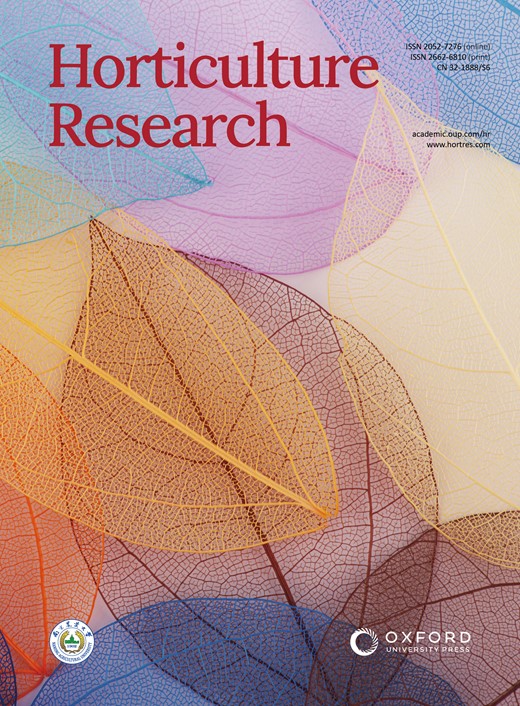通过基因组测序和代谢谱分析揭示了栎香菇风味增强的遗传基础
IF 8.5
1区 农林科学
Q1 Agricultural and Biological Sciences
引用次数: 0
摘要
布栎是广泛分布于中国亚热带地区的一种常见的用材栎树。在本研究中,我们通过整合PacBio Sequel II、DNBseqTM和Hi-C测序平台获得了Q. fabri染色体尺度的参考基因组组装,结果表明Q. fabri基因组大小为836.74 Mb。通过对显著扩展的基因家族的分析,我们发现许多排名前几位的KEGG通路与氨基酸代谢有关。随后,我们进行了棉铃虫和近缘种棉铃虫的氨基酸代谢谱分析,包括Q. aliena、Q. acutissima和Q. variabilis。结果表明,法布栎的氨基酸含量显著高于其他3种栎。此外,我们还发现棉籽中谷氨酸(Glu)、天冬氨酸(Asp)和甘氨酸(Gly)等风味氨基酸的含量显著高于棉籽。考虑到这些结果,我们设计了实验来评估从四棵橡树培养的蘑菇的营养含量。结果表明,以布氏栎为底物栽培的蘑菇总氨基酸和蛋白质含量显著高于其他3种栎。这一特性也许可以解释为什么法布里木作为培养更有味道的蘑菇的基质特别有效。本研究提供了棉铃虫的完整基因组和进化信息,并整合了代谢分析,以探索从其培养的蘑菇增强风味的潜在原因。本文章由计算机程序翻译,如有差异,请以英文原文为准。
Uncovering the genetic basis for enhanced mushroom flavor in Quercus fabri through genome sequencing and metabolic profiling
Quercus fabri is a common timber oak tree species widely distributed in subtropical areas of China. In this study, we presented a chromosome-scale reference genome assembly of Q. fabri achieved by integrating PacBio Sequel II, DNBseqTM and Hi-C sequencing platforms, and the results indicated the Q. fabri genome has a size of 836.74 Mb. Through the analysis of significantly expanded gene families, we identified that many of the top-ranked KEGG pathways are associated with amino acid metabolism. Subsequently, we performed an amino acid metabolic profile analysis on Q. fabri and related species, including Q. aliena, Q. acutissima, and Q. variabilis. The findings revealed that the content of amino acids in Q. fabri was significantly higher than that in the other three oak species. Additionally, we found a significantly higher content of flavor amino acids, such as glutamic acid (Glu), aspartic acid (Asp), and glycine (Gly), in Q. fabri. Considering these results, we designed experiments to assess the nutrient content in mushrooms cultivated from the four oak trees. The results indicated that the total amino acid and protein content of mushrooms cultivated using Q. fabri as a substrate was significantly greater than that of mushrooms grown on the other three oak species. This characteristic may explain why Q. fabri wood is particularly effective as a substrate for cultivating more flavorful mushrooms. This study presents the complete genome and evolutionary information of Q. fabri, and integrates metabolic profiling to explore the underlying reasons for the enhanced flavor of mushrooms cultivated from it.
求助全文
通过发布文献求助,成功后即可免费获取论文全文。
去求助
来源期刊

Horticulture Research
Biochemistry, Genetics and Molecular Biology-Biochemistry
CiteScore
11.20
自引率
6.90%
发文量
367
审稿时长
20 weeks
期刊介绍:
Horticulture Research, an open access journal affiliated with Nanjing Agricultural University, has achieved the prestigious ranking of number one in the Horticulture category of the Journal Citation Reports ™ from Clarivate, 2022. As a leading publication in the field, the journal is dedicated to disseminating original research articles, comprehensive reviews, insightful perspectives, thought-provoking comments, and valuable correspondence articles and letters to the editor. Its scope encompasses all vital aspects of horticultural plants and disciplines, such as biotechnology, breeding, cellular and molecular biology, evolution, genetics, inter-species interactions, physiology, and the origination and domestication of crops.
 求助内容:
求助内容: 应助结果提醒方式:
应助结果提醒方式:


